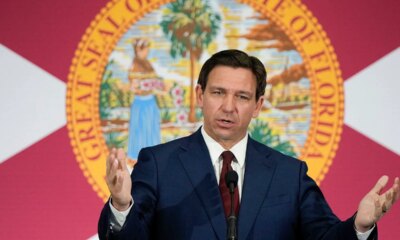FORT LAUDERDALE, Fla. (AP) — Milton strengthened into a major hurricane Monday on a path toward Florida population centers including Tampa and Orlando, threatening a dangerous storm surge in Tampa Bay and setting the stage for potential mass evacuations less than two weeks after a catastrophic Hurricane Helene swamped the coastline.
Milton grew into a Category 3 hurricane with maximum sustained winds of 125 mph (205 kph) over the southern Gulf of Mexico. Storm surge and hurricane watches were issued for Florida’s Gulf Coast, and a hurricane warning was issued for parts of Mexico’s Yucatan Peninsula.
The storm was expected to strengthen into an extremely dangerous Category 4 hurricane later Monday, with winds of at least 130 mph (210 kph), and stay at that strength for the next couple of days, the National Hurricane Center said. Helene was also a Category 4 at landfall in northern Florida.
The most likely scenario would have Milton’s center come ashore Wednesday in the Tampa Bay area and the storm remain a hurricane as it moves across central Florida toward the Atlantic Ocean, forecasters said. That would largely spare other states ravaged by Helene, which killed at least 230 people on its path from northern Florida to the Appalachian Mountains.
Milton’s center was about 165 miles (265 kilometers) west-northwest of Progreso, Mexico, and about 745 miles (1,195 kilometers) west-southwest of Tampa early Monday, moving east-southeast at 8 mph (13 kph), according to the hurricane center.
Milton is a bit atypical since it formed so far west and is expected to cross the entire southern Gulf, according to Daniel Brown, a hurricane specialist at the center.
“It’s not uncommon to get a hurricane threat in October along the west coast of Florida, but forming all the way in the southwest Gulf and then striking Florida is a little bit more unusual,” Brown said. Most storms that form in October and hit Florida come from the Caribbean, not the southwestern Gulf, he said.
Forecasters warned of a possible 8- to 12-foot storm surge (2.4 to 3.6 meters) in Tampa Bay and said flash and river flooding could result from 5 to 10 inches (13 to 25 centimeters) of rain in mainland Florida and the Keys, with as much as 15 inches (38 centimeters) in places.
Florida Gov. Ron DeSantis said Sunday that while it remains to be seen where Milton will strike, it’s clear the state is going to be hit hard.
“You have time to prepare — all day today, all day Monday, probably all day Tuesday to be sure your hurricane preparedness plan is in place,” DeSantis said. “If you’re on that west coast of Florida, barrier islands, just assume you’ll be asked to leave.”
About 7 million people were urged to evacuate Florida in 2017 as Hurricane Irma bore down. The exodus jammed freeways, led to long lines at gas stations and left evacuees in some cases vowing never to evacuate again.
Building on lessons learned during Irma and other previous storms, Florida is staging emergency fuel for gas vehicles and charging stations for electric vehicles along evacuation routes, Kevin Guthrie, executive director of the Florida Division of Emergency Management, said Sunday.
“We are preparing … for the largest evacuation that we have seen, most likely since 2017, Hurricane Irma,” Guthrie said.
The Tampa Bay area is still cleaning up extensive damage from Helene and its powerful surge. Twelve people perished as Helene swamped the coast, with the worst damage along the narrow, 20-mile (32-kilometer) string of barrier islands that stretch from St. Petersburg to Clearwater.
DeSantis expanded his state of emergency declaration Sunday to 51 counties and said Floridians should prepare for more power outages and disruption, making sure they have a week’s worth of food and water and are ready to hit the road.
People who live in homes built after Florida strengthened codes in 2004, who don’t depend on constant electricity and who aren’t in evacuation zones should probably avoid the roads, Guthrie said.
All classes and school activities in Pinellas County, home to St. Petersburg, closed preemptively Monday through Wednesday. Officials in Tampa freed all city garages to residents hoping to protect their cars from flooding, including electric vehicles. The vehicles must be left on the third floor or higher in each garage.
As many as 4,000 National Guard troops are helping state crews to remove debris, DeSantis said, and he directed Florida crews dispatched to North Carolina in Helene’s aftermath to return in preparation for Milton.
When Milton achieved hurricane status, it marked the first time there have been three hurricanes swirling simultaneously in the Atlantic, said Colorado State University hurricane scientist Phil Klotzbach. Hurricanes Leslie and Kirk were far out at sea and not immediately threatening land.














































